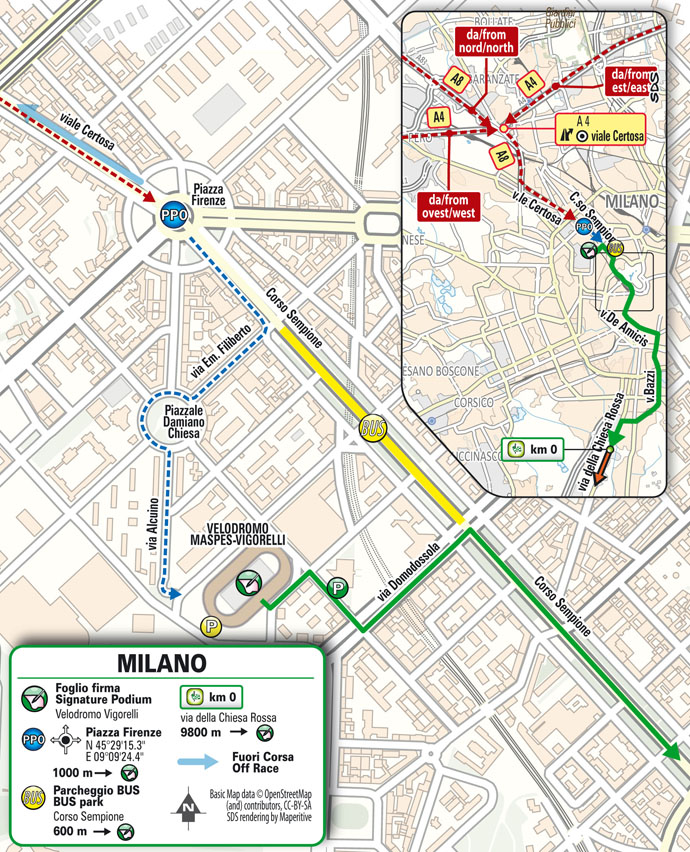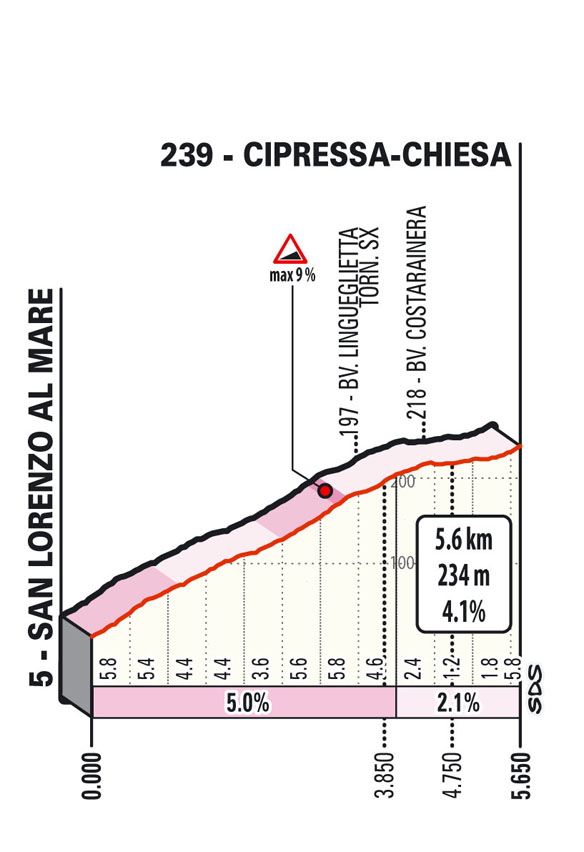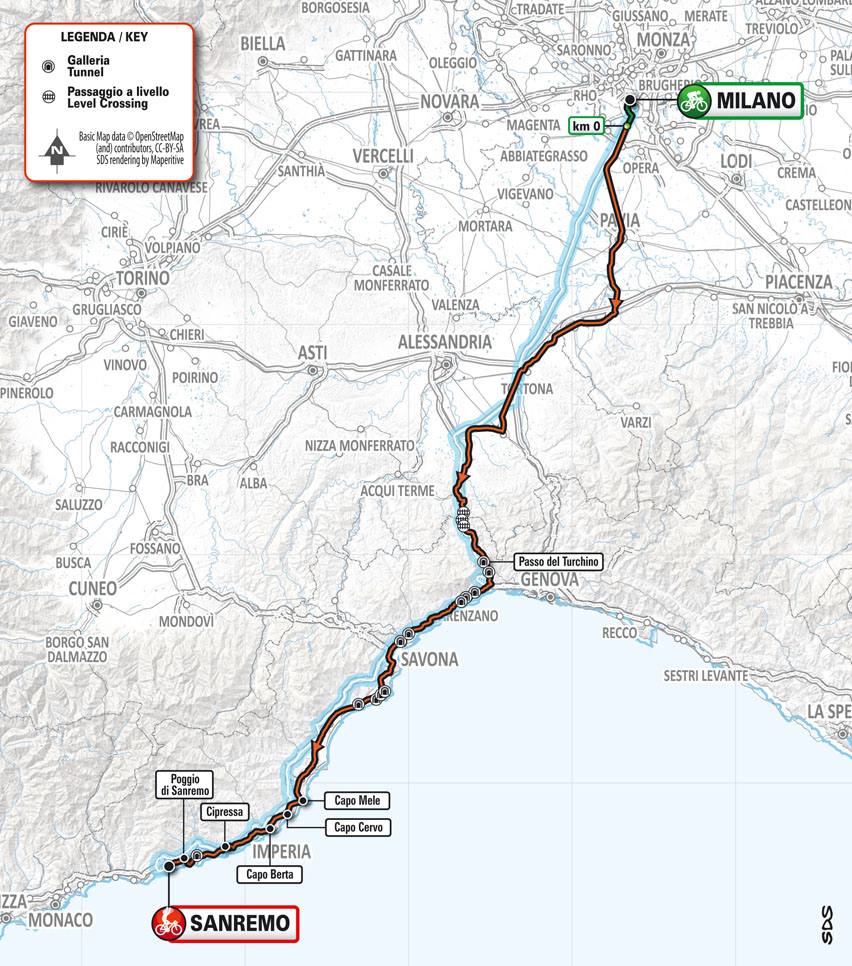profile
map
technical info
The Route
Milano-Sanremo runs along the classic route that for more than 110 years has connected Milan with the western Riviera through Pavia, Ovada, the Passo del Turchino that leads into Genua Voltri. From there, it rolls westwards through Varazze, Savona, Albenga to Imperia and San Lorenzo al Mare where, after the classic sequence of the Capi (Mele, Cervo and Berta), the atheltes will deal with the two climbs added in recent decades: the Cipressa (1982) and the Poggio di Sanremo (1961). The Cipressa is just over 5.6 km long with a gradient of 4.1%. The highly testing descent leads back down to SS 1 Aurelia.
Final kilometres
The ascent of Poggio di Sanremo begins with 9 km remaining to the finish (3.7 km, average gradient less than 4%, maximum 8% in the segment before getting to the top of the climb). The road is slightly narrower, with 4 hairpin turns in the first 2 km. The descent is testing, on asphalt switchback roads, narrow at points and with twists and turns as far as the junction with SS 1 Aurelia. The final part of the descent enters urban Sanremo. The last 2 km are on long, straight urban roads. There is a left-hand bend on a roundabout 850 m from the finish line. The last bend, leading into the home straight in Via Roma, is 750 m from the finish line.
start / finish


climb detail


final kilometres
itinerary timetable


tourist info
Host city:
Milano
Touristic information
In the words of the Italian singer Lucio Dalla, in the late 1970s, Milan was “a European city, a financial centre, the home of the stock exchange”. And even today, Milan is considered the key financial and economic hub of the country. Europe is only a short distance away, just past the Alps, which are clearly visible in the background behind the amazing architecture of the skyscrapers of the Isola and CityLife districts on bright sunny days.
Milan is also synonymous with fashion and design, advertising and trendsetting. It is home to some of the leading ‘made in Italy’ brands, and the venue of the famous Fashion Weeks that attract large crowds of industry specialists, fashion addicts and enthusiasts every year.
A major centre for art, publishing and opera, Milan has a network of globally famous theatres and museums, including Teatro alla Scala (one of the leading opera houses in the world), Pinacoteca di Brera, Museo del Novecento, Museo della Scienza e della Tecnologia ‘Leonardo da Vinci’, Villa Reale, Mudec and Museo civico di storia naturale.
Milan boasts a long-standing tradition in literature, art, music and science that is reflected in the city’s universities, buildings and churches. Major legacy of the rich history of the city includes Ca’ Granda, Palazzo Reale, the Sforza Castle, the Duomo, Leonardo’s Navigli, the Basilica of Sant’Ambrogio and the Basilica of Santa Maria delle Grazie, which holds Leonardo’s ‘Last Supper’.
Lastly, the urban fabric of Milan reflects a passion for sports, such as football, with the “derby della Madonnina” between Milan and Inter, one of the oldest matches in Italy, basketball, with Olimpia Milano, one of the major teams in Europe, and of course cycling. Milan has been the historical headquarter of many important Italian bicycle manufacturers, a traditional finish location for the Giro d’Italia, and the start city of the ‘springtime Classicissima’, Milano-Sanremo
Sanremo
Touristic information
Lying along the sun-drenched Riviera dei Fiori, Sanremo has a mild and pleasant micro‑climate, as compared to other cities of the region, which makes it the perfect tourist destination.
It is renowned for flower farming (hence its nickname, ‘the city of flowers’) and for a traditional parade of flower-covered floats held every year in the spring, called ‘Sanremo in fiore’. Other famous events taking place in Sanremo every year include the Italian Song Festival, aired by the national broadcaster Rai, and the Rassegna della canzone d’autore, organised by the Club Tenco.
The old town centre (nicknamed La Pigna, ‘the pine cone’, after the shape of its ancient defensive walls) reflects the glorious past of the city. Main sights include the Basilica Collegiata Cattedrale di San Siro, the sanctuary of Madonna della Costa, the hermitage of San Michele, and the Church of Cristo Salvatore, built in the late 19th century by the Russian nobility, nowadays one of the symbols of the town, together with the Casino, nearby, one of the three remaining in Italy.
Notable sights also include many private mansions built along the promenade: Palazzo Bellevue (which has been a luxury hotel for many years, and became the city hall in 1963); Palazzo Borea d’Olmo (one of the major Baroque buildings of western Liguria, a few metres away from Teatro Ariston); Villa Ormond (renowned for its park, with many exotic plants); Villa Nobel (built in Moorish style, the last place where Alfred Nobel lived, currently a museum and a venue for cultural meetings), Villa King, nearby (Art Deco), and Castello Devachan (the venue of the meeting of the victorious Allies after the end of World War I in 1920).
Speaking of sports, the city is renowned as finish location of Milano-Sanremo (one of the major springtime classics on the international cycling calendar), and it has been the venue of an iconic automobile rally since 1928.










































